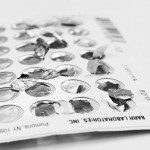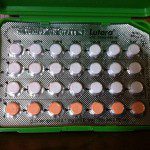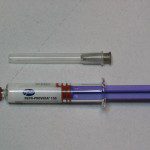![https://commons.wikimedia.org/wiki/File%3AQuecksilber-Basalthermometer.jpg; By Gelegenheitsautor (Own work) [Public domain], via Wikimedia Commons](https://wp-media.patheos.com/blogs/sites/533/2016/11/800px-Quecksilber-Basalthermometer.jpg)
Lost in all the pre-election reporting was a report about a potential new male contraceptive injection. Or, rather, about an injection with, as it turned out, not much potential after all, as a study was published which reported that trials of this potential injection were halted when it was determined that the degree of side effects, everything from acne to mood disorders to long-lasting infertility, was too high to continue the trials. As the site Heat Street reports, that didn’t stop some from criticizing the decision on twitter, accusing the participants of being crybabies, and equating their experience with what women on the pill put up with every day, even though the side effects were actually much worse.
Now, moving past my irritation at this anti-male attitude, that it’s OK for men to suffer, this is certainly another indication that hormonal contraception is unsatisfactory for a significant portion of the population, even without regard to Catholic church teaching. Witness, too, the growing popularity of Kindara — according to a recent article, 30% of the 750,000 women who have downloaded this app are using it to avoid rather than achieve pregnancy. And that’s just one of a number of apps that apply Natural Family Planning/Fertility Awareness* rules to help women avoid a pregnancy (here’s a partial list).
(*Terminology reminder: Natural Family Planning pregnancy avoidance denotes abstinence when a woman is in the fertile part of her cycle; Fertility Awareness includes the optional use of barriers when fertile. Both, of course, use the same methods for identifying the fertile phase. I suspect, though I don’t really know, that there are probably also women who practice something in-between, say, by using condoms at the edges of the fertile period, but abstaining when most fertile. In some contexts the two terms are interchangeable, but any research studies must necessarily be of NFP not FAM.)
And recall the Economist article to which I linked the other day, reporting that even in a number of “developed” countries, condoms are the contraceptive method of choice; the article’s point of view is that this is just a result of backwardness and ignorance, rather than a rational rejection of hormones and implants.
So that’s the context, that suggests that if there were a more high-tech, more reliable and/or more user-friendly method of implementing NFP concepts, there’d be a clear market for it.
And, as it happens, there are such methods — or, at least, potentially. In fact, one of these alternate methods was first patented 30 years ago. Could’ve been a game-changer. But all the grant money from the government and foundations is going to fund hormonal contraceptives and condom research, so you’ve probably never heard of it.
But let’s backtrack a bit.
I’ve written a couple blog posts lately on the subject of effectiveness, and the fact that a German study found a 98% user effectiveness rate for NFP, and that the 24% failure rate that the CDC cites is based on women in a survey group who seemed to consider themselves to be using some sort of do-it-yourself calendar rhythm method.
But, as a bit of a primer, we need to establish that there are multiple methods of NFP, looking at different ways of identifying fertile days. Billings, Creighton, Marquette, Sympto-Thermal, Taking Charge of Your Fertility — these are all types of NFP, with their own approaches, but, ultimately, each method needs to identify the start and the end of the fertile period. I’ve also been following a couple facebook groups, and have been learning that some women take a “kitchen sink” approach.
What do I mean?
To identify the start of the fertile period, you can use a strict calendar approach — if your cycles are regular, you can use a 5 or 6 day approach. Another method is a sort of calendar + past history approach. Other methods use a “dry day” approach with respect to cervical mucus. And the most conservative users consider every pre-ovulatory day potentially fertile, because they don’t want to take any chances.
To identify the end of the fertile period, the conventional methods are to count “post-peak drying up days” or use a basal thermometer to count three high temperatures. But there are some additional methods: Marquette Method users identify the LH surge that immediately precedes ovulation via urine test strips, then count a fixed number of days. And some women who cannot risk a pregnancy for health reasons go a step further and do something I’d never imagined, getting a monthly blood test for progesterone levels to confirm ovulation.
Now, using mucus patterns plus temperature is labelled “symptothermal.” Billings and Creighton refer to two different systems of tracking mucus alone. And by “kitchen sink” users I mean those who add in the OPKs (ovulation predictor kits), either as a formal or informal method, as well as other symptoms.
Now, for many women, these methods work great. For other women, it’s a struggle (though, yes, the difficulties are magnified in a facebook group, since it’s women who have difficulty who are more likely to post, and I don’t know of any statistics). Cervical mucus patterns might be clear as mud. Erratic schedules might make temperature-taking difficult. And the post-partum period is even more difficult, until regular cycles return.
So technology ought to save the day, in the year 2016.
To be sure, there are some promising possibilities.
The Kindara Wink is a thermometer which automatically syncs to your smartphone, so that, assuming you can manage the temping in the mornings, the tracking is simplified. Yono is an in-ear thermometer (like an earbud), which promises to simplify temping even further, by automatically taking your temperature as you sleep. And the TempDrop is a similar concept, except that it is an under-arm thermometer, worn with an armband. (There’s an insert-it-and-forget-it variant, the Priya Ring, but this lasts for only a month per device, and is not yet on the market, but will cost big bucks when it is.) But these are still all just high-tech thermometers by start-ups.
Moving beyond this, there’s a wearable, Ava, which claims to detect fertile periods, though with an accuracy level only suitable for women seeking to achieve, rather than avoid, pregnancy, though the website lists “possible use as a non-hormonal contraceptive device” as an area for further research.
And there’s a start-up developing urine test strips to test for progesterone rather than lutenizing hormone, so as to confirm, rather than predict, ovulation. This would be a godsend for women currently getting monthly blood tests, and helpful for other women as a double-check.
But all of this is new. The “missed opportunities”? Well, one’s been around for over two decades: the Clear Blue Fertility Monitor/Persona device. (I wrote about this back in 2015.)
These are a pair of devices: in the U.S., it’s marketed as a fertility monitor; in Europe, as a device for pregnancy avoidance. It’s the same device, a touch-screen reader of urine test sticks for estrogen and LH, just with differences in programming. And, surprisingly enough, the Persona device was sold in Europe, beginning in 1994, before the manufacturer began selling the device in the U.S. as a pregnancy-achievement device.
What happened?
According to a 1996 Wall Street Journal article, the manufacturer submitted the device to the FDA for approval in 1996, with hopes to have the device on the market in 1998. A further article in 1997 describes testing in the U.S., with a control group using condoms – but then the trail goes cold, at least as far as information that’s available online without access to a research library. Based on a bit more digging, I learned (no references here) that the trial did not go well, for unknown reasons. The FDA’s benchmark seems to have been that the device must be more effective than condoms — perhaps the control group was comprised of particularly skilled condom-users? In any case, at the same time, there are reports that, in Europe, users were experiencing more unplanned pregnancies using the device than expected. I’m told that the company abandoned its clinical trials in the U.S. (which would have been rather costly, and all the more expensive to repeat) and marketed the device as a fertility monitor instead, and, at the same time, adjusted the programming of the Persona monitor in Europe, to begin the fertile window earlier, with a lower threshold for detection of estrogen.
Now, shortly after this, researchers at Marquette University debuted the “Marquette Method” of NFP, which makes use of the Clear Blue monitor, but from what I can tell, it’s an imperfect solution. Because the threshold level for identifying fertility is higher with the ClearBlue than with Persona, it cannot be used directly to identify the beginning of the fertile window in the same way as the Persona device does. The Marquette researchers have also developed an approach for postpartum cycles which seems quite useful for women who otherwise struggle to identify their fertile periods, but, because the ClearBlue monitor is programmed only for women with regular cycles, users must implement certain work-arounds. From everything that I’ve learned, users could greatly benefit if the company would create an alternate programming mode — but presumably the need to comply with FDA requirements as a conception-aid device only (as well as perhaps company indifference) prevent this.
But that’s only 20 years of missed opportunities. There’s another device which had a nearly 10 year head start on the Clear Blue/Persona: the OvaCue.
This device, from all appearances, is a vast improvement on the ClearBlue. Rather than use single-use test sticks, which can run $2 each retail (cheaper on ebay), it tests saliva to detect the beginning of fertility and vaginal fluids to detect the end of fertility, with sensors which are reusable in the same way as a thermometer is. The current version of the device offers the option of a hand-held monitor, or sensors that connect to an iPhone and app, either of which tracks a chart and marks low, high, and peak fertility days, and, mind you, their label of “low” and “high” is really more an NFP-like “not fertile” and “fertile” — the “high” fertility actually marking the beginning of the fertile period, and their website claims that they start their “fertility” identification a full six days before ovulation. It offers the promise of an effective method of identifying the fertile window, even in cases where cervical fluids might be difficult to interpret. What’s more, the saliva method requires checking first thing in the morning, before eating and drinking, but this is an improvement on the temperature-taking required by the more highly-effective methods of NFP, especially for women with irregular schedules or midnight feedings, since it should still be effective even if sleep has been interrupted. (How well it works for shift workers and others with truly irregular sleep patterns, I don’t know.) I would also hazard a guess that the usual difficulty of NFP methods, that their method effectiveness can be as high as 99% but user effectiveness is lower, would be improved if women had a monitor color-coding days to make the method easier and seem more objective.
Now, like the ClearBlue, the device is not approved by the FDA as a “contraceptive method.” And in my brief correspondence with the manufacturer, they indicated that they have no interest in submitting the device for testing because of the additional studies it would require.
But here’s the thing: studies have already been conducted, which are, at a minimum, highly promising.
The purpose of this study was to compare the CUE method for family planning with the Ovulation Detection Method for defining the fertile phase of the menstrual cycle. We evaluated 42 cycles from 10 women in Monterrey, Mexico, who were monitored by basal body temperatures, urinary LH, pelvic ultrasound, and the CUE monitor. The fertile phase of the cycle was adequately defined in all cycles using the CUE method, and in 35 cycles (83.3%) by the Ovulation Method. Using our protocol, the period of recommended abstinence with the CUE method is 9 days and with the Ovulation Method 11 days. The CUE method accurately defines the fertile phase of the menstrual cycle, thus improving the predictability of ovulation for women who use natural methods of birth control.
PIP:
To evaluate the potential utility of the CUE method in natural family planning (NFP), this method was compared with a standard NFP technique, the Ovulation Method, in 39 cycles of 10 women from Monterrey, Mexico. All women had more than 2 years’ experience with the Ovulation Method. In the CUE method, ovulation prediction is based on a peak in salivary electrical resistance and its confirmation by a rise in vaginal resistance as monitored by a hand-held electronic instrument attached to a specially designed sensor. The CUE method defined the fertile period of all 39 cycles adequately, while the Ovulation Method resulted in incorrect definition of the fertile phase in 4 (10%) of 39 cycles. The salivary peak predicted ovulation an average of 8 days in advance of its occurrence and the increase in vaginal readings in the periovulatory period was seen within 1 day of follicle collapse in all subjects. The duration of abstinence required by the CUE method would have averaged 9.0 +or- 1.5 days (range, 6-13 days). In contrast, the average duration of abstinence associated with the Ovulation Method was 11.0 +or- 2.9 days (range, 6-16 days). 82% of cycles monitored by the CUE method compared with only 53% of those monitored by the Ovulation Method would have required a period of abstinence of 10 days or less. The simplicity and objectivity of the CUE method, combined with its requirement for fewer days of abstinence, offer the potential for improving NFP compliance and continuation.
“Data from 21 menstrual cycles showed no statistical difference (T = 0.33, P = 0.63) between the CUE fertile period, which ranged from 5 to 10 days (mean =6.7 days, SD =1.6), and the fertile period of the ovulation method, which ranged from 4 to 9 days (mean = 6.5 days, SO = 2.0). The CUE has potential as an adjunctive device in the learning and use of natural family planning methods.”
Why was this research abandoned? To be sure, the FDA-required studies to market the device as “contraception” could easily have been simply too danged expensive to conduct for a small-scale manufacturer, when the clearance to sell as a generic “medical device” was much cheaper. Were there subsequent studies, unpublished or unavailable online, which revealed that the OvaCue was a dead-end for pregnancy-avoidance? (The second article cited above suggests that it was more reliable in detecting the start rather than the end of the fertile period, so its effectiveness would be boosted by combining it with other methods.) Was it Zetek that supported the NFP research, so that when this company went out of business this research/support stopped? Is the trying-to-conceive business simply so huge that, at least in the U.S., any potential revenue to a company from marketing a device for pregnancy-avoidance purposes is miniscule in comparison? (And, if so, is Persona on the market in Europe because European women are more keen to avoid hormones and less keen to buy “TTC” products than American women, or is the European approvals process less burdensome?)
All of which seems to boil down to a huge missed opportunity, either for someone with the cash to fund the necessary studies to be able to market the device as suitable for pregnancy avoidance, or at least, even if they can’t meet the FDA’s requirements in terms of study size and control group, to define an appropriate set of rules for use and document an effectiveness rate based on those rules. Perhaps the solution is partly political, say, with an amendment tucked into a bill somewhere that would all NFP-aid devices to meet a different standard, say, effectiveness relative to other forms of NFP, so as to allow current NFP users who don’t wish to use condoms, to join a test study.













